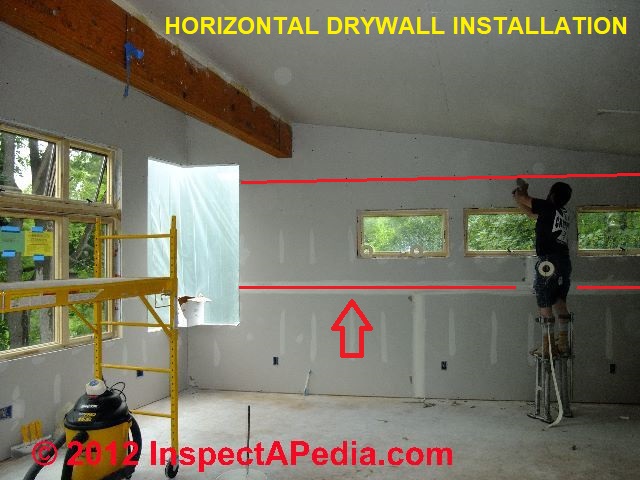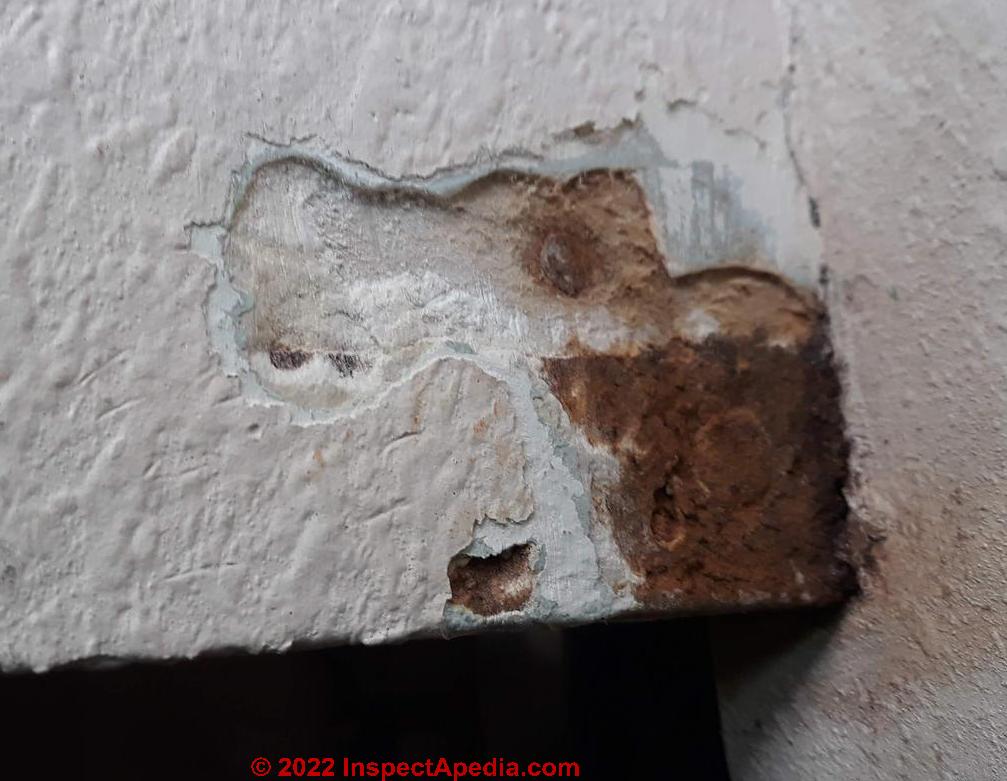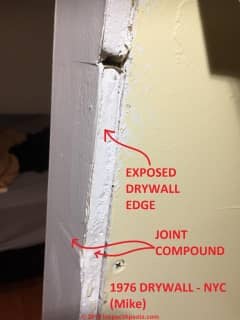 How to Remove or Encapsulate Asbestos-Drywall & Joint Compound
How to Remove or Encapsulate Asbestos-Drywall & Joint Compound
What to do if you suspect your drywall contains asbestos
- POST a QUESTION or COMMENT about the level of asbestos found in drywall or drywall mud (drywall joint compound) on walls & ceilings.
What's the best way to manage drywall or "sheetrock" containing or suspected of containing asbestos?
This article series explains where asbestos is likely to be found in gypsum board or drywall systems, particularly in the taping compound and in skim coats using drywall "mud" that contained asbestos.
InspectAPedia tolerates no conflicts of interest. We have no relationship with advertisers, products, or services discussed at this website.
- Daniel Friedman, Publisher/Editor/Author - See WHO ARE WE?
Drywall & Joint Compound Asbestos Remediation
How to Cover or Remove Asbestos-Containing Drywall or Joint Compound
 Modern drywall and taping compound do not contain asbestos.
Modern drywall and taping compound do not contain asbestos.
Drywall systems that may contain asbestos - at least in finishes, taping joint compounds, skim coats, or in systems that applied plaster over gypsum board date from about 1910 through the early 1980's in North America (1982 in Canada).
Taping drywall joints dates from as early as the 1920's. Asbestos use in plaster overlaps this period.
Watch out: do not disturb asbestos-suspect drywall materials; it's generally safest to leave such materials alone or to cover them. If demolition or removal is required, then the additional steps discussed here are pertinent.
Article Contents
- DOES ASBESTOS-SUSPECT DRYWALL NEED TO BE TESTED? - not always
- DRYWALL REMOVAL PROCEDURE - SMALL JOBS
- DRYWALL REMOVAL PROCEDURE - BIG JOBS
- ENCAPSULATE / COVER EXPOSED DRYWALL EDGES?
- REGULATIONS & STANDARDS for ASBESTOS-CONTAINING DRYWALL REMOVAL
Asbestos-suspect drywall damage ranges from very small like the water-damaged drywall shown in Julie M's photo just above, to extensive potential dust hazards during demolition of interior walls or ceilings.
For a small area of damage like this one, you should find and fix the water leak source, then spray paint with lacquer primer sealer, then repair with modern non-asbestos joint compound or drywall patch.
...
Do You Need to Test Asbestos-Suspect Drywall?
- No Asbestos Test Needed:
If building materials in your home aren’t damaged and won’t be disturbed, you do not need to have your home tested for asbestos. - EPA - Asbestos Test Recommended:
IF in an older building (built before 1980 in North America) you are not sure if drywall or gypsum board or drywall joint compound used in your building contains asbestos
AND if the drywall must be disturbed so as to create a dust hazard, such as demolition or power-sawing,
THEN you should have a certified asbestos test lab examine representative samples of both the drywall (usually does not contain asbestos) and samples of the joint compound (found in greatest quantity at drywall sheet joints and often containing asbestos).
Watch out: Keep in mind that even if it contains no asbestos, drywall and joint compound dust creates ultra-fine particles that can be a serious respiratory hazard.
Don't Attempt an Amateur Drywall Removal If it Contains Asbestos
Watch out: because drywall dust and joint compound dust is easily airborne and easily made friable (by sanding, cutting, sawing or other demolition operations) our best advice and opinion is that you should not try a do-it-yourself asbestos-containing drywall removal project.
Nevertheless if you live in an area where homeowner removal or repair of asbestos-containing drywall is permitted and you insist on attempting the work yourself, take appropriate steps for dust control and personal protection, such as using thorough wetting procedures and using damp mopping and damp wiping for cleanup.
Turn off and protect all air handling equipment (air conditioners, furnaces, humidifiers, dehumidifiers, fans) before disturbing asbestos-containing materials.
Do not use a conventional vacuum cleaner as it will aerate asbestos particles. Some HEPA-rated vacuum cleaners may also fail to handle asbestos and may increase airborne asbestos levels.
Beware that while the asbestos content in drywall (uncommon) or joint compound (common) may be relatively low, some spray-on popcorn or textured ceiling treatments can be very high in asbestos content, up to 40% or even more.
Really? Well yes but the text above refers to dusty work that characterizes actual removal of existing drywall by ripping, chopping, sawing, breaking up a significant area, perhaps half or entire walls or ceilings.
A small drywall task such as nailing a picture hanging nail or small screw into a wall does not merit asbestos tests nor other heroic dust containment measures.
...
Typical Drywall Removal Procedure for Small Jobs
A "small job" can be considered disturbing or removing less than one square metre of drywall where asbestos-containing joint-compound was used.
- Use of a respirator fitted with new or tested P100 filtered cartridges and disposable coveralls is optional for small removal jobs
- Install a poly drop sheet beneath the work area using duct tape
- Mist the drywall to be removed concentrating on corners and any areas where seams are visible or suspected to be present
- Continue to mist any suspect material as work progresses
- Dispose of all waste material as regular construction debris (asbestos waste disposal might be required depending on where you live).
Is water alone an adequate wetting agent? Possibly not. Many of the asbestos-drywall removal articles we reviewed advise using a wetting agent to reduce the surface tension of water, improving its wetting and penetrating properties.
An amended water solution can often be made simply by adding one cup of dishwasher detergent to 20 liters of water.
...
Typical Drywall Removal Procedure for Larger Jobs & Drywall Demolition
- Shutdown the HVAC system affecting the work area. Cover all HVAC vents and diffusers.
- Don approved respirator (fitted with new or tested P100 filtered cartridges) and disposable coveralls
- Mist the drywall to be removed concentrating on corners and any areas where seams are visible or suspected to be present
See ASBESTOS REMOVAL, WETTING GUIDELINES - Continue to mist any suspect material as work progresses
- Control dust in area by misting fallen debris
- Dispose of all waste material as regular construction debris (asbestos waste disposal is or is not required, depending on where you live and what codes apply).
Note: Special waste disposal or air monitoring may be required for this type of work, or a duly authorized asbestos work permit is required, depending on where you live and what codes apply).
- Source: DRYWALL REMOVAL PROCEDURES, ASBESTOS-CONTAINING [PDF] University of Manitoba, Asbestos Management Program, https://umanitoba.ca/campus/ physical_plant/health_safety/ media/Drywall_Removal.pdf
...
How to Encapsulate Exposed Asbestos-Suspect Drywall Edges in Good Condition
Readers have asked if the exposed edges of drywall exposed in one or more occupied spaces in their buildings need special treatment to protect against asbestos-suspect drywall dust release.
Readers also ask if taping over the area or painting it is sufficient encapsulation for the area to be considered safe.
So: should we seal or tape over exposed drywall edges (photo just above) or other areas of damage such as a small hole or crack?
IF the age of the building or other information tell us that the drywall could be old enough that it or joint compound used in ins installation could contain asbestos, then we should treat that drywall with some caution.
In the U.S., drywall from 1976 (or joint compound such as visible in the photo above) can contain asbestos, an experienced environmental consultant won't bet your health or your worry (itself a health concern) on a mere oral or written question other than to say "Sure - let's do something easy".
Methods for encapsulating small exposed or damaged drywall / gypsum board surfaces
- Do nothing: as the US EPA advises, if asbestos-suspect drywall is in good condition and is not going to be disturbed, simply leave it alone.
- Paint over the exposed edges of the drywall
with any convenient paint. Use two coats for better protection.
This is appropriate for a situation like that in reader Mike's photo above where the drywall is on an outside, exposed corner, a bit damaged, and vulnerable.
While there are special asbestos-encapsulating paints sold for this purpose, in my OPINION just about any interior paint will seal the drywall edges just fine.
Paint alone will do a good job at avoiding simple dust shedding (though undisturbed not much dust would shed in any case, perhaps not even a detectable amount), but adding wood trim will avoid damage in the future, improving the installation.
- Trim over the exposed edges of drywall:
Particularly if the drywall edge such as the wall corner above is in a location where it may be damaged by ordinary building occupants and activities, paint the exposed drywall edges, then enclose the area in neat wood trim.
Really? The U.S. EPA notes that the potential hazard from asbestos-containing drywall or drywall coated with asbestos-containing joint compound occurs principally if the drywall is damaged.
That's because normally the asbestos-containing gypsum inside drywall is covered by the paper surface of the drywall itself along with subsequent layers of wallpaper or paint.
- Generally, you can't tell whether a material contains asbestos simply by looking at it, unless it is labeled.
- If in doubt, treat the material as if it contains asbestos and leave it alone.
- You may want to have your home inspected for asbestos-containing materials by a trained and accredited asbestos professional if:
- You are planning to remodel your home (remodeling can disturb building materials)
- Your home has damaged building materials (like crumbling drywall and insulation that is falling apart)
A trained and accredited asbestos professional should take samples for analysis, since a professional knows what to look for, and because there may be an increased health risk if fibers are released.
In fact, if done incorrectly, sampling can be more hazardous than leaving the material alone.
Taking samples yourself is not recommended. - If building materials in your home aren’t damaged and won’t be disturbed, you do not need to have your home tested for asbestos.
- Material that is in good condition and will not be disturbed (by remodeling, for example) should be left alone.
Source of the above: - U.S. EPA:
- PROTECT YOUR FAMILY FROM EXPOSURES TO ASBESTOS [PDF] retrieved 2019/04/26 original source: https://www.epa.gov/asbestos/protect-your-family-exposures-asbestos
...
Minimize & Control Dust with Asbestos Drywall
Information on lessening the asbestos hazard and increasing dust control with working with asbestos drywall can now be found
at ASBESTOS-DRYWALL DUST CONTROL
...
Asbestos-Containing Drywall Removal Practices & Guidelines
- ASBESTOS ABATEMENT PRECAUTIONS [PDF] (2014) Parks Canada, Pt Pelee Concession Building Project No 30023823 retrieved 20178/04/23, original source https://buyandsell.gc.ca/cds/public/2014/02/21/ ecdd9979121582d545d91bedc9c108a8/02_82_10_-_ asbestos_abatement_type_1.pdf
- ASBESTOS CONTAINING DRYWALL DISPOSAL [PDF] (2011) BCMSA, British Columbia Municipal Safety Association, Mike Roberts, Exec. Dir., 20430 Fraser Highway, Langley, BC V3A 4G2 Tel: 778-278-3486 Website: https://www.bcmsa.ca Email:mroberts@bcmsa.caretrieved 2018/04/23, original source: https://www.bcmsa.ca/wp-content/uploads/downloads/2011/11/MANUAL-Asbestos-Containing-Drywall-Disposal-2.pdf
- ASBESTOS A GUIDE for MINOR RENOVATION [PDF] (2016) Queensland Government, qld.gov.au/asbestos 13 QGOV (13 74 68) This guide, produced by the Queensland Government, is based on an original guide entitled Asbestos: A home renovator’s and tradesperson’s guide for minor work in domestic buildings.
http://www.deir.qld.gov.au/asbestos/resources/pdfs/asbestos-home-renovators-trades-guide.pdf - ASBESTOS REMOVAL CERTIFICATIONS at InspectApedia.com
- ASBESTOS REMOVAL GUIDE [PDF] IHSA Ontario, Canada, 5110 Creekbank Road, Suite 400 Mississauga, ON L4W 0A1 Canada Tel: 905-625-0100Tel: 1-800-263-5024 Health Safety Manual, retrieved 2018/04/23, original source: https://www.ihsa.ca/rtf/health_safety_manual/pdfs/hazards/Asbestos.pdf
- ASBESTOS REMOVAL, WETTING GUIDELINES at InspectApedia.com
- DRYWALL REMOVAL WORK PRACTICE [PDF] University of Washington, Facilities Services, https://facilities.uw.edu/catalog/rmo/guide/acm-wallboard
- DRYWALL REMOVAL PROCEDURES, ASBESTOS-CONTAINING [PDF] University of Manitoba, Asbestos Management Program,
https://umanitoba.ca/campus/physical_plant/health_safety/media/Drywall_Removal.pdf - NIOSH PROTECT YOUR FAMILY REDUCE CONTAMINATION AT HOME [PDF] US DEHS, US CDC / NIOSH
- US EPA PROTECT YOUR FAMILY FROM EXPOSURES TO ASBESTOS [PDF] retrieved 2019/04/26 original source: https://www.epa.gov/asbestos/protect-your-family-exposures-asbestos
- US CDC ATSDR / OSHA FACT SHEET - ASBESTOS [PDF]
www.osha.gov, or call OSHA at 1-800-321-OSHA
(6742), TTY 1-877-889-5627.Local clopy on file as Asbestos-Fact-Sheet-OSHA3507.pdf
In 1986, OSHA in Standard 29 CFR 1910.1001 established the current permissible exposure limit (PEL) for asbestos in the workplace: (0.1 fibers/cc of air as a time weighed average) [OSHA 2012].
PELs are allowable exposure levels in workplace air averaged over an 8-hour shift of a 40 hour work week.
There are also OSHA standards (29 CFR 1915.1001) for shipyards and construction (1926.1101).
Additionally, OSHA standards (1915.1001 and 1926.1101) requires employers of all workers whose work exposes them to asbestos above the PEL or excursion limit (1.0 f/cc over 30-minute period) to
- Provide training in the engineering controls, work practices, and proper use of personal protective equipment (PPE)
- Train workers in safety before beginning work and annually
- Train workers regarding the health effects of asbestos exposure, and
- Inform workers of the relationship between smoking, asbestos exposure and increased risk of lung cancer
- In addition, OSHA requires employers of workers who are exposed to asbestos above the PEL and who are employed in certain asbestos industries to
[take additional measures such as training and protection] - https://www.atsdr.cdc.gov/csem/asbestos/standards_and_regulations.html
The following protections exist in the OSHA Standards:
Permissible Exposure Limit (PEL) for asbestos is 0.1 fiber per cubic centimeter of air as an eight-hour time-weighted average (TWA), with an excursion limit (EL) of 1.0 asbestos fibers per cubic centimeter over a 30-minute period.
The employer must ensure that no one is exposed above these limits. - https://www.osha.gov/sites/default/files/publications/OSHA3507.pdf
...
...
Continue reading at ASBESTOS-DRYWALL DUST CONTROL or select a topic from the closely-related articles below, or see the complete ARTICLE INDEX.
Or see these ASBESTOS-DRYWALL REMEDIATION / REMOVAL FAQs - questions & answers about how to remove or encapsulate asbestos drywall, posted originally on this page.
Or see these
Recommended Articles
- AIR HANDLER DUST CONTAMINATION - drywall dust in HVAC equipment
- ASBESTOS IDENTIFICATION IN BUILDINGS
- ASBESTOS in PLASTER - what about the use of asbestos in plaster walls & ceilings?
- DRYWALL, FIBERBOARD, PLASTER INTERIORS - home
- ASBESTOS CEMENT CEILING & WALL PANELS
- ASBESTOS in DRYWALL
- ASBESTOS in DRYWALL MUD - TEST LOCATIONS
- ASBESTOS in DRYWALL TAPE?
- ASBESTOS-DRYWALL REMEDIATION / REMOVAL
- ASBESTOS-DRYWALL DUST CONTROL
- ASBESTOS-SUSPECT DRYWALL ENCAPSULATE in PLACE
- BESTWALL DRYWALL ASBESTOS
- CELOTEX DRYWALL ASBESTOS
- CHINESE DRYWALL HAZARDS
- DOMTAR GYPROC ASBESTOS?
- DRYWALL & GYPSUM BOARD COMPOSITION & HISTORY
- DRYWALL TYPE IDENTIFICATION STAMPS
- DRYWALL INSTALLATION Best Practices
- DRYWALL INSTALLATION HORIZONTAL vs VERTICAL
- GYPSUM BOARD GYP ROCK SHEATHING
- GYPSUM BOARD PLASTER LATH SYSTEMS
- IGNIFUGE GYPSUM BOARD ASBESTOS?
- NATIONAL GYPSUM DRYWALL ASBESTOS?
- PLASTER TYPES & METHODS in BUILDINGS
- PLASTER INGREDIENTS, MIX, PROPERTIES
- SHEATHING, GYPSUM BOARD
- WOOD LATH for PLASTER or STUCCO
Suggested citation for this web page
ASBESTOS-DRYWALL REMEDIATION / REMOVAL at InspectApedia.com - online encyclopedia of building & environmental inspection, testing, diagnosis, repair, & problem prevention advice.
Or see this
INDEX to RELATED ARTICLES: ARTICLE INDEX to ASBESTOS HAZARDS
Or use the SEARCH BOX found below to Ask a Question or Search InspectApedia
Ask a Question or Search InspectApedia
Try the search box just below, or if you prefer, post a question or comment in the Comments box below and we will respond promptly.
Search the InspectApedia website
Note: appearance of your Comment below may be delayed: if your comment contains an image, photograph, web link, or text that looks to the software as if it might be a web link, your posting will appear after it has been approved by a moderator. Apologies for the delay.
Only one image can be added per comment but you can post as many comments, and therefore images, as you like.
You will not receive a notification when a response to your question has been posted.
Please bookmark this page to make it easy for you to check back for our response.
IF above you see "Comment Form is loading comments..." then COMMENT BOX - countable.ca / bawkbox.com IS NOT WORKING.
In any case you are welcome to send an email directly to us at InspectApedia.com at editor@inspectApedia.com
We'll reply to you directly. Please help us help you by noting, in your email, the URL of the InspectApedia page where you wanted to comment.
Citations & References
In addition to any citations in the article above, a full list is available on request.
- In addition to citations & references found in this article, see the research citations given at the end of the related articles found at our suggested
CONTINUE READING or RECOMMENDED ARTICLES.
- Carson, Dunlop & Associates Ltd., 120 Carlton Street Suite 407, Toronto ON M5A 4K2. Tel: (416) 964-9415 1-800-268-7070 Email: info@carsondunlop.com. Alan Carson is a past president of ASHI, the American Society of Home Inspectors.
Thanks to Alan Carson and Bob Dunlop, for permission for InspectAPedia to use text excerpts from The HOME REFERENCE BOOK - the Encyclopedia of Homes and to use illustrations from The ILLUSTRATED HOME .
Carson Dunlop Associates provides extensive home inspection education and report writing material. In gratitude we provide links to tsome Carson Dunlop Associates products and services.


